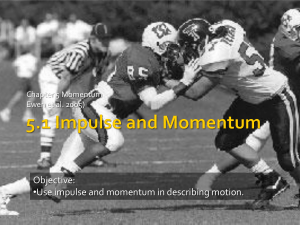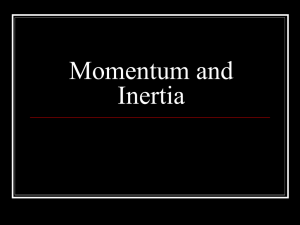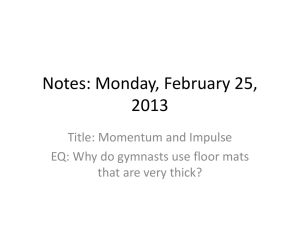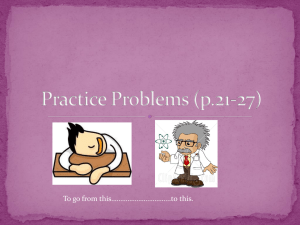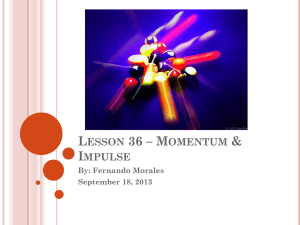principle of linear impulse and momentum
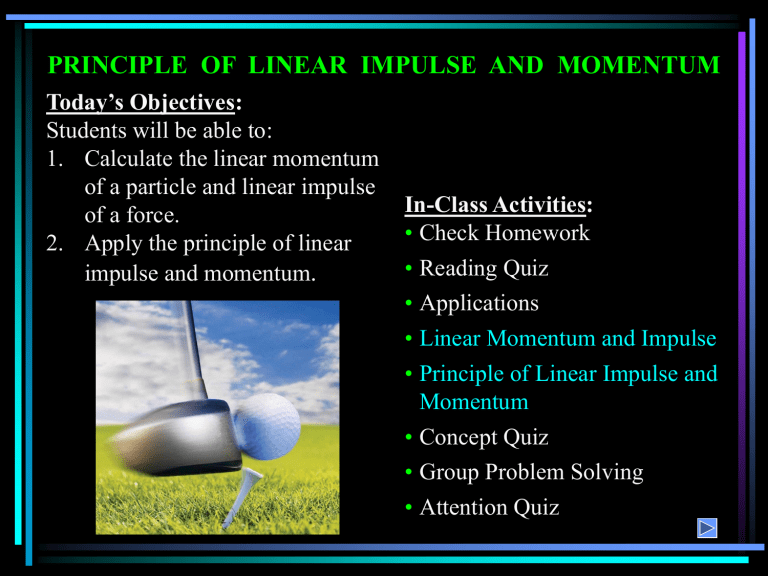
PRINCIPLE OF LINEAR IMPULSE AND MOMENTUM
Today’s Objectives:
Students will be able to:
1. Calculate the linear momentum of a particle and linear impulse of a force.
2. Apply the principle of linear impulse and momentum .
In-Class Activities:
• Check Homework
•
Reading Quiz
• Applications
•
Linear Momentum and Impulse
• Principle of Linear Impulse and
Momentum
•
Concept Quiz
•
Group Problem Solving
•
Attention Quiz
READING QUIZ
1. The linear impulse and momentum equation is obtained by integrating the ______ with respect to time.
A) friction force
C) kinetic energy
B) equation of motion
D) potential energy
2. Which parameter is not involved in the linear impulse and momentum equation?
A) Velocity
C) Time
B) Displacement
D) Force
APPLICATIONS
A dent in an automotive fender can be removed using an impulse tool, which delivers a force over a very short time interval. To do so the weight is gripped and jerked upwards, striking the stop ring.
How can we determine the magnitude of the linear impulse applied to the fender?
Could you analyze a carpenter’s hammer striking a nail in the same fashion?
Sure!
APPLICATIONS
(continued)
When a stake is struck by a sledgehammer, a large impulse force is delivered to the stake and drives it into the ground.
If we know the initial speed of the sledgehammer and the duration of impact, how can we determine the magnitude of the impulsive force delivered to the stake?
PRINCIPLE OF LINEAR IMPULSE AND MOMENTUM
(Section 15.1)
The next method we will consider for solving particle kinetics problems is obtained by integrating the equation of motion with respect to time .
The result is referred to as the principle of impulse and momentum . It can be applied to problems involving both linear and angular motion.
This principle is useful for solving problems that involve force , velocity , and time . It can also be used to analyze the mechanics of impact (taken up in a later section).
PRINCIPLE OF LINEAR IMPULSE AND MOMENTUM
(continued)
The principle of linear impulse and momentum is obtained by integrating the equation of motion with respect to time.
The equation of motion can be written
F = m a = m (d v /dt)
Separating variables and integrating between the limits v = v
1 at t = t
1 and v = v
2 at t = t
2 results in
t
2
t
1
F dt = m v
1
v
2 d v = m v
2
– m v
1
This equation represents the principle of linear impulse and momentum. It relates the particle’s final velocity ( v
2
) and initial velocity ( v
1
) and the forces acting on the particle as a function of time.
PRINCIPLE OF LINEAR IMPULSE AND MOMENTUM
(continued)
Linear momentum : The vector m v is called the linear momentum, denoted as L . This vector has the same direction as v . The linear momentum vector has units of (kg·m)/s or (slug·ft)/s.
Linear impulse : The integral
F dt is the linear impulse, denoted
I . It is a vector quantity measuring the effect of a force during its time interval of action. I acts in the same direction as F and has units of N·s or lb·s.
The impulse may be determined by direct integration . Graphically, it can be represented by the area under the force versus time curve . If F is constant, then
I = F (t
2
– t
1
) .
PRINCIPLE OF LINEAR IMPULSE AND MOMENTUM
(continued)
The principle of linear impulse and momentum in vector form is written as m v
1
+
t
2 t
1
F dt = m v
2
The particle’s initial momentum plus the sum of all the impulses applied from t
1 to t
2 is equal to the particle’s final momentum.
The two momentum diagrams indicate direction and magnitude of the particle’s initial and final momentum, m v
1 and m v
2
. The impulse diagram similar to a free body diagram, but includes the is time duration of the forces acting on the particle.
IMPULSE AND MOMENTUM: SCALAR EQUATIONS
Since the principle of linear impulse and momentum is a vector equation, it can be resolved into its x, y, z component scalar equations : m(v x
)
1 t
2
+
F x t
1 dt = m(v x
)
2 m(v y
)
1 t
2
+
F y t
1 t
2 dt = m(v y
)
2 m(v z
)
1
+
F z dt = m(v z
)
2 t
1
The scalar equations provide a convenient means for applying the principle of linear impulse and momentum once the velocity and force vectors have been resolved into x, y, z components.
PROBLEM SOLVING
•
Establish the x, y, z coordinate system .
• Draw the particle’s free body diagram and establish the direction of the particle’s initial and final velocities, drawing the impulse and momentum diagrams for the particle. Show the linear momenta and force impulse vectors.
•
Resolve the force and velocity (or impulse and momentum) vectors into their x, y, z components , and apply the principle of linear impulse and momentum using its scalar form.
•
Forces as functions of time must be integrated to obtain impulses. If a force is constant, its impulse is the product of the force’s magnitude and time interval over which it acts.
EXAMPLE
Given: A 0.5 kg ball strikes the rough ground and rebounds with the velocities shown . Neglect the ball’s weight during the time it impacts the ground.
Find: The magnitude of impulsive force exerted on the ball.
Plan:
1) Draw the momentum and impulse diagrams of the ball as it hits the surface.
2) Apply the principle of impulse and momentum to determine the impulsive force.
EXAMPLE
(continued)
Solution:
1) The impulse and momentum diagrams can be drawn as:
W dt
0 m v
2
+ = 30°
45° m v
1
F dt
N dt
0
The impulse caused by the ball’s weight and the normal force N can be neglected because their magnitudes are very small as compared to the impulse from the ground.
EXAMPLE
(continued)
2) The principle of impulse and momentum can be applied along the direction of motion: m v
1
t
2
+
F dt = m v
2 t
1
t
2
0.5 (25 cos 45° i
− 25 sin 45° j ) +
F dt t
1 = 0.5 (10 cos 30° i + 10 sin 30° j )
The impulsive force vector is
t
2
I =
F dt = (4.509 i + 11.34 j ) N
s t
1
Magnitude: I = √ 4.509
2 + 11.34
2 = 12.2 N
s
CHECK YOUR UNDERSTANDING QUIZ
F
1. Calculate the impulse due to the force. 10 N
A) 20 kg·m/s B) 10 kg·m/s
C) 5 N·s D) 15 N·s
Force curve
2 s
2. A constant force F is applied for 2 s to change the particle’s velocity from v
1 to v
2
. Determine the force F if the particle’s mass is 2 kg.
A) (17.3 j ) N B) (–10 i +17.3 j ) N
C) (20 i +17.3 j ) N D) ( 10 i +17.3 j ) N v
2
=20 m/s
60
v
1
=10 m/s t
GROUP PROBLEM SOLVING
Given: The 20 kg crate is resting on the floor. The motor M pulls on the cable with a force of F , which has a magnitude that varies as shown on the graph.
Find: The speed of the crate when t = 6 s.
Plan:
1) Determine the force needed to begin lifting the crate, and then the time needed for the motor to generate this force.
2) After the crate starts moving, apply the principle of impulse and momentum to determine the speed of the crate at t = 6 s.
GROUP PROBLEM SOLVING (continued)
Solution:
1) The crate begins moving when the cable force F exceeds the crate weight . Solve for the force, then the time.
F = mg = (20) (9.81) = 196.2 N
F = 196.2 N = 50 t t = 3.924 s
2) Apply the principle of impulse and momentum from the time the crate starts lifting at t
1
= 3.924
s to t
2
= 6 s.
Note that there are two external forces (cable force and weight) we need to consider.
A. The impulse due to cable force :
+↑ 6
F dt = [0.5(250) 5 + (250) 1] – 0.5(196.2)3.924= 490.1 N
s
3.924
GROUP PROBLEM SOLVING (continued)
B. The impulse due to weight :
6
(− mg) dt = − 196.2 (6 − 3.924) =
3.924
− 407.3 N s
Now, apply the principle of impulse and momentum
+↑ mv
1
+
t
2 t
1
F dt = mv
2 where v
1
= 0
0 + 490.1 − 407.3 = (20) v
2
=> v
2
= 4.14 m/s
ATTENTION QUIZ
1. Jet engines on the 100 Mg VTOL aircraft exert a constant vertical force of 981 kN as it hovers. Determine the net impulse on the aircraft over t = 10 s.
A) -981 kN·s B) 0 kN·s
C) 981 kN·s D) 9810 kN·s
2. A 100 lb cabinet is placed on a smooth surface. If a force of a 100 lb is applied for 2 s, determine the net impulse on the cabinet during this time interval .
A) 0 lb·s B) 100 lb·s
C) 200 lb·s D) 300 lb·s
30

